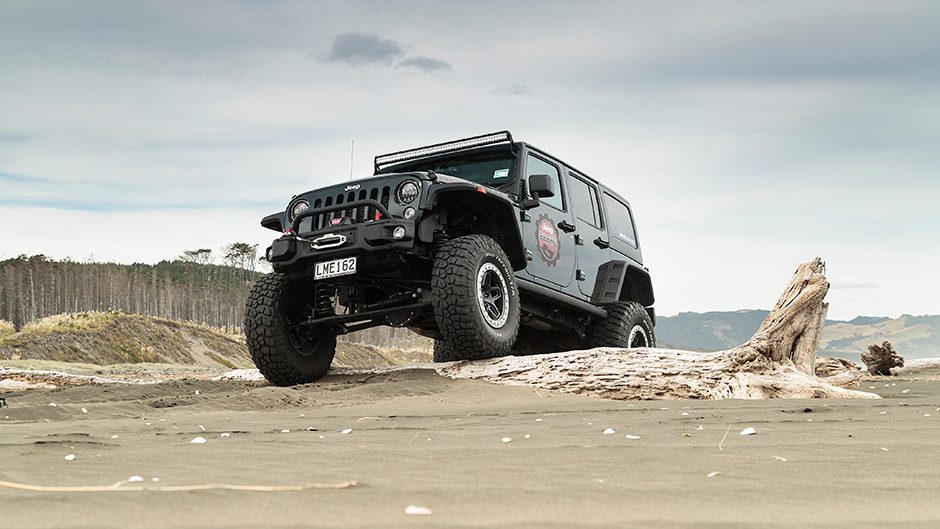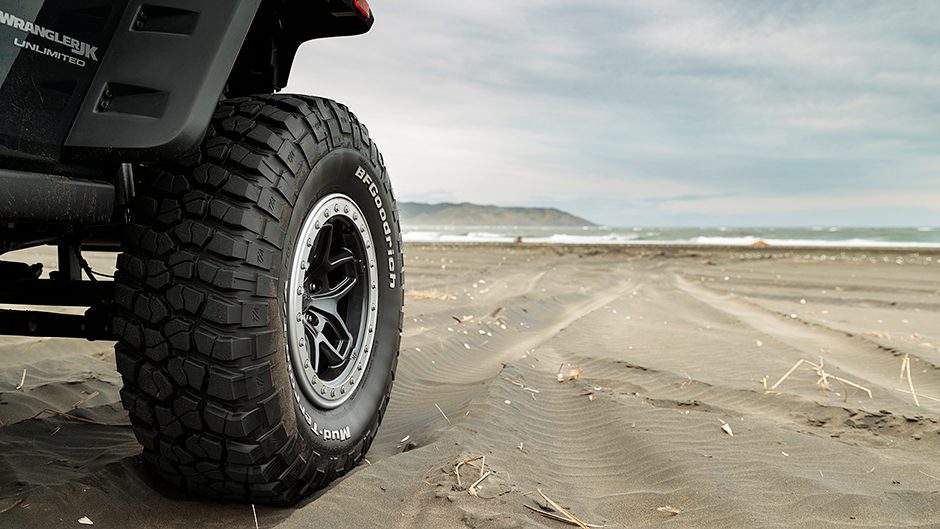2018 Jeep Wrangler Unlimited Rubicon Mopar review
Words Kyle Cassidy | Photos Tom Gasnier
Jeep’s newest Wrangler arrives here soon. If you can’t spring for the new one, why not give your existing JK a birthday present of some Mopar parts. Here we check out what can be achieved.
Jeep’s Wrangler is designed with rough roading in mind. It’s reminiscent of the original Jeep with bugger all overhang, plenty of clearance, and it even perseveres with solid axles front and rear. Wrangler’s enduring success however is its mix of utilitarianism and civility; it’s user friendly enough that most owners drive them around town, never really venturing into the wilds.
But for those who do, Jeep has the Rubicon model, an off-road-primed version with sturdier underpinnings and bits like a disconnecting front sway bar for added articulation, and rock rails to protect the body from impacts with immovable forces. But you can also take the Wrangler to the next level with a variety of Mopar parts available from your local Jeep dealer, like this rolling ensemble of extras.
Our JK Unlimited Rubicon model has been treated to a liberal coating of Mopar (FCA’s official line of accessories, performance parts and service items) and AEV (American Expedition Vehicles, specialising in serious off-road, FCA-based vehicles and parts) bolt-on bits to show just what’s possible when you free up the purse strings. Those of most interest would be the lift kit and rolling stock. The full AEV kit adds 4.5 inches to the ride height by way of new bump-stop spacers, coil springs and Bilstein shockers. AEV’s kit includes special drop brackets to allow the stock control arms to be retained.

These also help maintain the geometry of the control arms, so that the higher riding Wrangler still behaves with civility on road. When manufacturers want a car to handle better, they usually trim the ride height by 10 or 20mm, so you can imagine what adding 114mm does to the Wrangler. However, the AEV kit looks to minimise the negative effects on road. For instance, on the steering system, the rack bar is relocated to raise the roll centre closer to the new centre of gravity, which helps make it steer more like the factory Wrangler.
The drag link is also relocated to lessen the slop around centre and there’s a heavy duty steering damper as well. A new rear track bar tower is used to adjust rear roll centre. The new springs are frequency tuned which means when you hit a series of bumps, the front and rear spring rates are designed to settle the Wrangler again as quickly as possible so it’s not continually bucking over the rough terrain.
These are progressive rate springs too so it’s not super stiff when unladen. The Bilsteins are designed to AEV specs with valving specific to the lift kit. The rear units also gain remote reservoirs with the increased oil capacity helping maintain temperatures to better sustain serious abuse. The AEV kit is comprehensive, right down to a jack base to add clearance and stability to the stock lifter should you require a tyre change.

The new suspension does require wheels with a greater offset than stock, and while you can add a spacer to the factory wheels, you’d likely add something from the AEV catalogue, these 17s able to work with or without the beadlock functionality, which is apparently not road legal here. AEV also recommends a 37×12.5 inch off road tyre. We’ve experienced these lifted Wranglers previously with some genuine rock crawling antics in the Mount Aspiring region down south.
While the regular Rubicon models were able to pick their way slowly through the craggy gully, it wasn’t without a few rock rails tickled up, and a few bumpers bruised. The rigs on lift kits with the larger tyres proved unstoppable; they simply went where you pointed them. The added clearance allowed them to take a more direct route over boulders that would have had the regular Rubicons hung up.
Abbreviated bumpers reduce the overhangs to virtually nil and the big tyres latched on to the rock face as they climbed straight up. The extra articulation would see the axles and wheels crossed up at all angles as they rumbled over the rocks while the chassis and body remained fairly level, the ride over the rough terrain largely bounce free. We hardly challenged the off-road ability this time, only managing to spray a bit of sand around on the beach, but from the shots you can see it has serious articulation and ground clearance, and an ability to run in deep ruts.

But how does it go on road? Oddly enough, it manages to maintain its everyday usability. The turning circle is still okay, larger than stock but not unmanageable. The steering itself isn’t heavy, and the ride isn’t harsh either. It still moves about on its live axles, but there’s no bone-jarring stiffness. It does cry out for a reversing camera; you can’t see anything behind with the oversized spare attached. Clambering on board can be a challenge. You have to kick your leg up and then haul yourself in using the steering wheel or the grab handle.
Once in though you get a commanding view. The offspring needed to be lifted in and out, and when dropping them at school, one kid could be overheard saying ‘look Mum, a real monster truck!’. It has that kind of appeal to some, while others will look at you as if to say ‘planet killer’. As far as the handling goes, you need to take an ‘all things considered’ approach.
It’s riding high, on big rubber designed to cut through mud, and it still has live axles front and rear. As speeds rise, it can squirm around but it still rides reasonably well over the bumps. The rubber itself is pretty quiet with just a hint of hum at 100km/h. There’s still a decent amount of grip on offer, but not a whole heap of road feel.

The front responds well to steering inputs, but it does feel like the front goes first, then the rear follows. And it’s not unusual to make the odd steering adjustment midcorner for bends taken at a decent clip. As to straight line grunt, the V6’s 209kW and 347Nm are dulled by the larger tyres effectively increasing the gearing, it taking 11.1 seconds to crack 100km/h, and 8.5sec on the overtake.
The emergency stop produced a 46m effort, not great but then big tyres work the ABS hard. And it’s stable under brakes, just an initial dive when you first hit the pedal, but it rights itself quickly. Fuel use is up there, with an average in the high teens, and into the 20s at a few stages. There’s no problem with speedo accuracy here, reading 97 at an indicated 100. Part of the AEV kit is the means to recal the speedo and therefore the ESP, to work as intended with the bigger tyres.
All up the $70,990 Rubicon was wearing more than $33,000 worth of kit. And that’s just the cost of the parts on the shelf; fitting is extra. You’re encouraged to give it a go yourself as the Mopar bits are designed to bolt straight on up to the existing holes and brackets. Certainly the bumpers and bash plates you could do yourself, although the liftkit is best installed by someone with a bit more knowhow, and a hoist.

The lift kit lists for $4800, and the manual suggests around 10 hours to fit. There’s a modification required to the exhaust, an extra U-shaped bend has to be added to clear the front driveshaft. The five AEV Borah wheels are $3800 and another $3600 to shoe them in BF Goodrich pluggers.
The rest of the bits are out of the Mopar catalogue, apart from the lights which are items that are already certified for use in NZ. The seven-inch LED headlights look the part and while the 50-inch light bar running across the top illuminates the night, it creates a real rush of wind noise at 100km/h, and is worse when there’s a crosswind.
Other big ticket items include the Mopar Rubicon bonnet ($2974), front bumper ($3563), the Warn winch and mount are $4000, the flare kit is $1050 and the rear bumper is $2485. And such heavy wheels require a new spare wheel carrier on the rear ($2047) while other bits include various plates, guards and brackets.
It’s genuinely over the top but you can pick and choose the bits you want, and if you do go the whole hog, know the monster Wrangler is still streetable, but a whole lot more capable.















